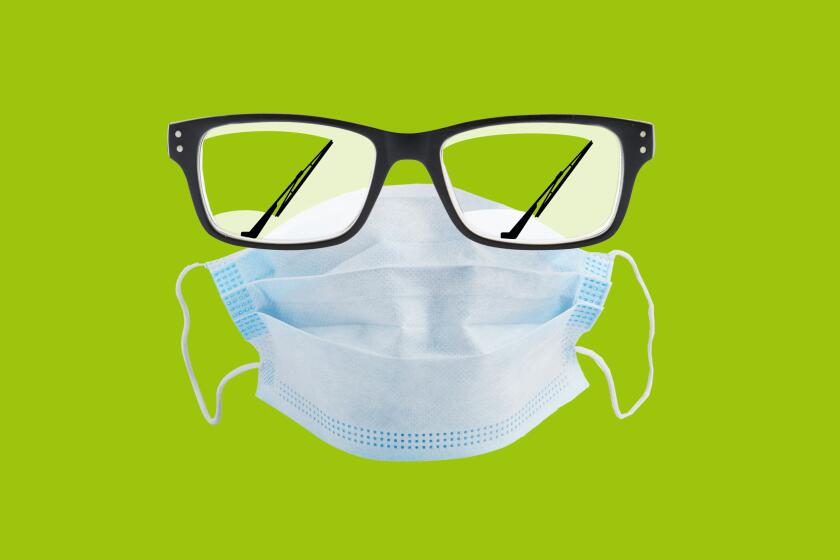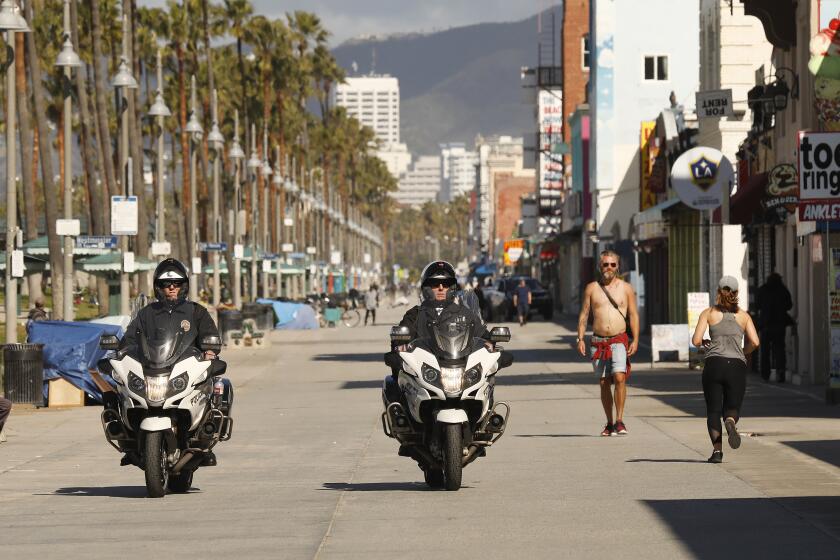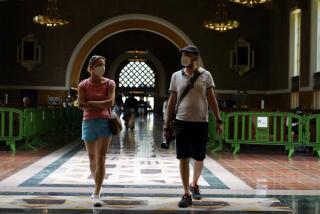Do I need to wear a mask when walking outside? In my car? Does my pet need one?

- Share via
Another day amid the coronavirus pandemic means another set of new rules Angelenos must follow to help flatten the curve.
Starting Friday, Los Angeles residents are required to wear a mask, bandanna or other type of covering over their mouths and noses when visiting essential businesses under an order from Mayor Eric Garcetti. Workers also must wear face coverings, which business owners must either provide or reimburse workers for buying.
Garcetti’s order is the latest effort to help stop the spread of the coronavirus and provides some relief for essential workers. The order focuses on people who are in public spaces where they cannot always remain six feet from others.
The call for people to wear face masks came a little too late, but better late than never, said Chunhuei Chi, director of the Center for Global Health at Oregon State University. He pointed to East Asian countries such as Japan and South Korea, where people have been wearing face masks since January, lowering the spread of coronavirus.
Dr. Loren Miller, a physician and researcher at the Lundquist Institute in Torrance, said the topic of face masks can be confusing, even among healthcare workers. The purpose of masks isn’t to protect the person wearing them but to shield the transfer of saliva onto another person, potentially causing infection, he said.
“If everyone wears a mask, we’re all protecting each other from each other,” Miller said.
The two health experts explained what to look for in a mask and other precautions that should be taken when using face coverings.
Wearing masks will help minimize the spread of COVID-19. Here’s how to do it right.
Should I wear masks when I’m hanging out in my neighborhood?
The short answer is yes, Miller said, because folks out for a stroll might not always be able to social distance for six feet when they come across other people.
Another option for people without masks is to do the “vampire move” or “dab,” where you put your elbow over your mouth, he said. If a person coughs or sneezes, it’ll go into their elbow.
Chi recommends wearing a mask only if you’ll be in close proximity to other people.
“If you walk in your neighborhood or go bicycling — as long as of course the family member with you can keep a safe distance — you don’t need a mask,” he said.
Health experts have also suggested to routinely wash your hands with soap and water or hand sanitizer before and after touching your face or face coverings.
As restrictions get tighter and stir-craziness grows, officials and Californians walk a delicate line on outdoor activity
If I go for a run, should I wear a mask?
It’s a good courtesy if runners can tolerate it, Miller said. In a place like Los Angeles, with trails, beaches and parks closed, it’s common to see people using sidewalks as their new exercise venue. In some cases, he said it might not always be feasible to stay at least six feet away from one another.
Chi said the same principle applies as if you were strolling in your neighborhood. If you can keep a safe distance from others, runners don’t have to wear a mask.
If the path isn’t wide enough to pass, Chi said, people can hold their breath until they’re in the clear. It’s one option he said he and his wife have used during their daily walks.
While nonessential businesses that say open may face sanctions, the LAPD said rumors it was ticketing people for exercising outdoors are untrue.
Should I wear a mask if I’m driving?
Unless the person is a taxi driver or giving someone else a ride, Chi and Miller said there’s little purpose in wearing a mask.
“The only time I can think of how it might be helpful is if someone was sneezing without a mask in the car,” Miller said. “They’re going to potentially contaminate the steering wheel and if that’s shared by other people, their hands will get contaminated and touch their hands, nose and mouth.”
Chi said people should always wear masks when using public transportation or ride-share cars.
We want to protect our loved ones from the coronavirus. For many of us, that includes our pets. Here’s what experts know about the risks they face.
I’ve seen masks on pets. Should I be taking those precautions?
Days after a tiger in New York tested positive for the coronavirus, owners are concerned their pets are susceptible to the disease.
The Bronx Zoo tiger case is believed to be the first known instance of person-to-animal infection in the United States. There have been reports of a small number of pets outside the United States becoming infected after close contact with contagious people, including a Hong Kong dog that tested positive for a low level of the pathogen in February and early March.
Miller and Chi said it may be too early to know how animals respond to the virus.
“The thing is animals might be able to get infected with coronavirus, but even if they’re infected, we don’t know if they become sick from it or if they can transmit it,” Miller said.
If people are concerned about their dog’s well-being during walks, Chi said they could use a muzzle.
“If the dog has a tendency to munch on anything on the ground, it’s risky,” he said. “Even though its risk is much lower than humans’, pets could get it.”
There’s a global shortage of COVID-19 face masks — so people around the world are getting creative in making their own.
What should I look for when buying a mask?
With a dwindling supply of N95 masks for hospital workers, many good Samaritans across Los Angeles have taken it upon themselves to create makeshift masks. Chances are you’ve seen them popping up on social media in a variety of styles and colors.
So what mask should you buy? Chi recommends purchasing those made of cotton or a blend of cotton and polyester. If buying isn’t an option, he suggests making masks out of pillowcases or cotton shirts.
“It’s all about the material,” he said. “Cotton or a blend of cotton and polyester has very fine open lines. It leaves very small spaces in between.”
Miller said the answer is a little more complicated. Surgical masks are the best, but because they’re in short supply, he said healthcare workers and immunocompromised people should be the only ones using them.
“Cloth masks are very different in their ability to protect from COVID-19 because there’s so many different types of clothes and cotton and it depends on the density of the weave and the type of material,” he said. “The short answer is we really don’t know.”
At this point, he suggests buying masks with material wide enough to securely cover the nose and mouth. He also recommends avoiding bandannas because they don’t fully cover the side of a person’s face.
Once surgical masks get moist, Miller said their effectiveness goes down. If a makeshift face mask gets moist or is visibly soiled, he said, it’s time to switch to a clean one.
To clean them, pop masks in the laundry or hand-wash them with soap and water. If feasible, grocery workers should have more than one pair to trade off and on during their shifts over the week. Otherwise, Chi said, they should wash them every night when they get home.
More to Read
Sign up for Essential California
The most important California stories and recommendations in your inbox every morning.
You may occasionally receive promotional content from the Los Angeles Times.

















